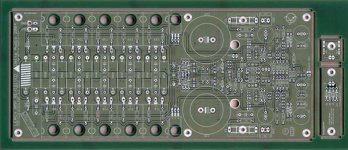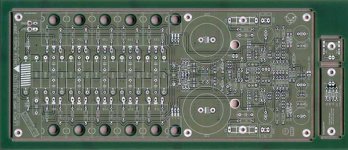Not quite the same page BP. See http://www.delta-audio.com/Leach-Clone.htm This board has 10 output devices.
BobEllis said:Wiki page http://www.diyaudio.com/wiki/index.php?page=Leach+amp+10+Output+device+Group+Buy+
Brute Puppy - that's the new layout awaiting prototyping. The Wiki has a link to the current board or you can visit http://www.delta-audio.com/Leach-Clone.htm to find Jens' writeup on his design.
Interest in original Jens version added to WIKI
Bob Ellis, can you please clarify - WIKI notes indicate a 55-65V PS is required. Is that refering to the Front End?
Rob - 55-65V is appropriate for the entire amp. That should net you between 125 and 150W RMS.
You can go down to a little over 45V, but below that you'll need to change the cascode reference zeners. You can go higher than 65, but then a few other things change and you need to watch the load impedance doesn't dip too low.
You can separate the front end an regulate it separately from the output rails if you wish.
You can go down to a little over 45V, but below that you'll need to change the cascode reference zeners. You can go higher than 65, but then a few other things change and you need to watch the load impedance doesn't dip too low.
You can separate the front end an regulate it separately from the output rails if you wish.
OK Bob,
Try the picture below. Now if that is correct, I have a question or three. Can I build an amp with this board using TO-3's and wire them from board to heat sinks? Can I build the board with less than 10 outputs per channel (like 4,6,or 8)? Are there part changes or jumpers required and who, where, will I get direction to build the lesser design?
Try the picture below. Now if that is correct, I have a question or three. Can I build an amp with this board using TO-3's and wire them from board to heat sinks? Can I build the board with less than 10 outputs per channel (like 4,6,or 8)? Are there part changes or jumpers required and who, where, will I get direction to build the lesser design?
Attachments
Fred - 0-45 VAC x 2 is heart of the envelope - you'll get about 62V rails. Professor Leach's recommended transformer is 600 VA, so, yes, I think that will do.
BP, that's the one.
Yes, as mentioned earlier you can use leads from the board to TO-3 sockets - the original Leach amp did. Stay with slower output devices and short as possible leads to minimize the risk of oscillation, though.
Yes, you can reduce the number of output devices used. No jumpers are required, just leave a pair or two unpopulated. Earlier in the thread a rough 3 plastic devices = 2 metal equivalency was mentioned.
The deign trade-offs are something you'll need to crank though yourself, although you'll get plenty of help here. There isn't a "how to scale my leach amp" reference I am aware of.
In general, at a given rail voltage, the fewer output devices, the less tolerant of low impedance loads the amp will be. You can improve this with more heat sink, but you'll need to run through safe operating area calculations that are both temperature and voltage dependent.
As rail voltage is reduces, the number of output devices needed decreases for a given load. If you want to drive a 1 ohm subwoofer array you'll still need multiple devices no matter what the rails.
While I know many are on a tight budget, IMHO, not fully populating the output section tends toward penny wise and pound foolish (false economy). Even at the single piece price, it costs less than $100 more to fully populate a pair of boards compared to using 3 pairs of outputs (the minimum recommended number of plastic outputs). In return you get a more robust amp that is tolerant of impedance dips at higher output levels. You can even use a bit less heat sink and still maintain reliability.
About the only instance I would consider not fully populating the output section would be for a dedicated tweeter amp in an active system.
BP, that's the one.
Yes, as mentioned earlier you can use leads from the board to TO-3 sockets - the original Leach amp did. Stay with slower output devices and short as possible leads to minimize the risk of oscillation, though.
Yes, you can reduce the number of output devices used. No jumpers are required, just leave a pair or two unpopulated. Earlier in the thread a rough 3 plastic devices = 2 metal equivalency was mentioned.
The deign trade-offs are something you'll need to crank though yourself, although you'll get plenty of help here. There isn't a "how to scale my leach amp" reference I am aware of.
In general, at a given rail voltage, the fewer output devices, the less tolerant of low impedance loads the amp will be. You can improve this with more heat sink, but you'll need to run through safe operating area calculations that are both temperature and voltage dependent.
As rail voltage is reduces, the number of output devices needed decreases for a given load. If you want to drive a 1 ohm subwoofer array you'll still need multiple devices no matter what the rails.
While I know many are on a tight budget, IMHO, not fully populating the output section tends toward penny wise and pound foolish (false economy). Even at the single piece price, it costs less than $100 more to fully populate a pair of boards compared to using 3 pairs of outputs (the minimum recommended number of plastic outputs). In return you get a more robust amp that is tolerant of impedance dips at higher output levels. You can even use a bit less heat sink and still maintain reliability.
About the only instance I would consider not fully populating the output section would be for a dedicated tweeter amp in an active system.
Phew! When I saw AndrewT had replied, I was afraid I'd messed up something with my answer. 
I'll add that except possibly subwoofer duty, you'll only be using a few watts most of the time anyway. 600 VA ought to be plenty. I use a 800VA transformer to feed four channels of each in my biamped system which never seems to get into rail sag. I have another amp for my subwoofers.
I'll add that except possibly subwoofer duty, you'll only be using a few watts most of the time anyway. 600 VA ought to be plenty. I use a 800VA transformer to feed four channels of each in my biamped system which never seems to get into rail sag. I have another amp for my subwoofers.
Bob,
I've got a pair of large (600VA, I think) transf., which each provide
a pair of +/- 72v rails for stereo use.
I can use one transf per channel (two monoblocks), and my speakers are 4ohms nominal, 3.2 min. Any suggestions or forseeable problems here?
Would the 5-transistor boards be ok, or should I go with the 6-transistor boards?
I've got a pair of large (600VA, I think) transf., which each provide
a pair of +/- 72v rails for stereo use.
I can use one transf per channel (two monoblocks), and my speakers are 4ohms nominal, 3.2 min. Any suggestions or forseeable problems here?
Would the 5-transistor boards be ok, or should I go with the 6-transistor boards?
You can go higher than 65, but then a few other things change and you need to watch the load impedance doesn't dip too low.
IIRC Jens is running a 10 output device amp at 75V - adjust the front end resistors R3, R12 for the rails (watch dissipation too), and don't try to use BC546/556- use MPSA42/92. They don't have the gain, but they will withstand higher voltages.
The problems you may have at 3.2 ohms depend on phase and signal amplitude. Unless you really push hard you should be OK if your heat sinks are properly sized.
800VA should run a pair comfortably, but since you already have a pair, why not go monoblock? I have an 800 VA transfomer driving 4 channels at 60V in a biamp setup. I use it at sane levels so I haven't had a problem with rails sagging.
BTW, in case you haven't followed the best 100W output transistors thread, OnSemi has a new 150W output device pair that looks pretty good MJW0281/0302 . The best news is Mouser's price is only $1.40 or $1.33 at 25 pieces. The similar but 200W rated MJW3281/1302 are only $1.70. Almost as cheap as BrutePuppy's eBay potential fakes.
The problems you may have at 3.2 ohms depend on phase and signal amplitude. Unless you really push hard you should be OK if your heat sinks are properly sized.
800VA should run a pair comfortably, but since you already have a pair, why not go monoblock? I have an 800 VA transfomer driving 4 channels at 60V in a biamp setup. I use it at sane levels so I haven't had a problem with rails sagging.
BTW, in case you haven't followed the best 100W output transistors thread, OnSemi has a new 150W output device pair that looks pretty good MJW0281/0302 . The best news is Mouser's price is only $1.40 or $1.33 at 25 pieces. The similar but 200W rated MJW3281/1302 are only $1.70. Almost as cheap as BrutePuppy's eBay potential fakes.
Chas - each board is a single channel, so for two monoblocks you'll want two.
go to the wiki, scroll down to the "edit this page" link, log in again with your DIYAudio name and password. Then you're ready to go.
Tad is running this buy. I just try to help out with technical stuff.
go to the wiki, scroll down to the "edit this page" link, log in again with your DIYAudio name and password. Then you're ready to go.
Tad is running this buy. I just try to help out with technical stuff.
We are up too 24 pcb's at this time. If we can get interest in 25 more boards I will submit an order for the new group buy of Jens 10 transistor amplifier.
For those out there who might like too know I used the On Semi mjl4281/4302 output devices and have been extremely happy with the way they sound. Shop around and you will find a huge difference in price.
This amp is truly a keeper for those who choose to build it they will not be let down. Tad
For those out there who might like too know I used the On Semi mjl4281/4302 output devices and have been extremely happy with the way they sound. Shop around and you will find a huge difference in price.
This amp is truly a keeper for those who choose to build it they will not be let down. Tad
Bob, I thought I mailed you a couple of these boards from the last group buy? I have checked on the prices before but mislaid the email from Advanced Circuits. I think it will be just north of 17.00 each. Last time I got the first time buyer discount of 500.00 which made the price on 150 boards look much nicer than it should have been. Anyway I can not tell you how great this amp sounds with the bias at close to 1 amp per rail. Truly marvelous as they say. Class A all the way from now on. Well at least until the one amp runs out. Tad
- Home
- Group Buys
- Jens Rasmussen Leach clone group buy


